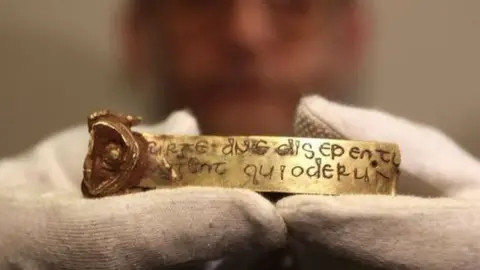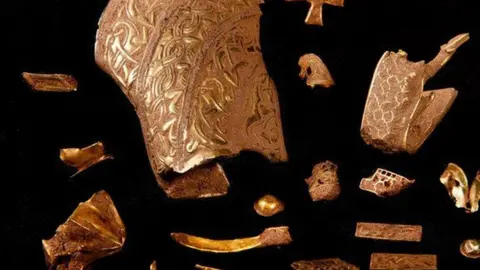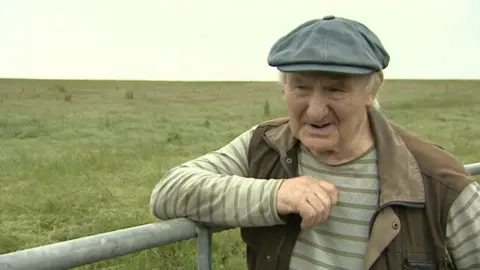Staffordshire Hoard farmer says windfall 'hasn't changed me'
 Getty Images
Getty ImagesA farmer who shared a £3.2m windfall after the Staffordshire Hoard was discovered in his field has said the money has not changed him.
Fred Johnson still lives on the farm where the biggest ever haul of Anglo-Saxon gold and silver was discovered 10 years ago by a metal detectorist.
Sword pommels, pieces of helmet and mysterious objects that still baffle archaeologists were discovered on land near Hammerwich in 2009.
They had been hidden there since 700AD.
"I can still remember the day as it if was yesterday," said Mr Johnson, who shared the value with Terry Herbert, the amateur detectorist who first came across the glittering fragments.
"If anyone had told me that there was treasure in one of my fields I would have laughed at them.
"When the metal detectorist showed me the first couple of items I wasn't too sure what they were. And then it kept on coming, more and more."
 Staffordshire County Council
Staffordshire County Council
Archaeologists swooped on Mr Johnson's land, which was cordoned off. Rumours ran rife around the village about what could be happening.
Philip Atkins, the leader of Staffordshire County Council then and now, said of those early days following the discovery: "We had to go and secure the site and make sure the digger was there and so, with that type of activity going on, we had to come up with an alternative story.
"There was the possibility of searching for a body after an unknown murder but actually breaking the story the day before to senior members of the staff - I had to ask them if they could really keep a secret."
About 4,000 fragments were unearthed in the field in 2009, beginning a lengthy campaign to remove each delicate piece, which dated from the 7th and 8th Centuries.
When Birmingham Museum and Art Gallery and The Potteries Museum in Stoke-on-Trent revealed the news two months later, it attracted worldwide attention.
 Stoke-on-Trent City Council
Stoke-on-Trent City Council It was dubbed the most significant Anglo-Saxon hoard ever found in Britain, possibly even in Europe. A total of 14,000 pieces were eventually discovered.
Steve Dean, the archaeologist who oversaw the excavation, said: "As a discovery, it just blew you away."
When the hoard first went on display to the public people queued for hours to see it.
Declared treasure and given a value of £3.2m, the region did manage to keep it in the local area. It is now jointly owned by Birmingham City Council and Stoke-on-Trent City Council.
The entire collection is now displayed across four sites in the Midlands - at the Potteries Museum, Birmingham Museum and Art Gallery, Lichfield Cathedral and Tamworth Castle.
Under law, the money was then divided between the finder and the landowner.
Mr Johnson said: "I tried not to let it change me, I still mix with the people I grew up with.
"I was a little bit worried about going into town for my shopping but I needn't have, because people came up to me and shook my hand and said 'good luck to you' and I'm grateful for that."
 Birmingham Museum
Birmingham Museum
Follow BBC West Midlands on Facebook, on Twitter, and sign up for local news updates direct to your phone.
